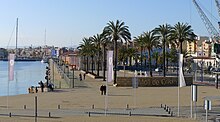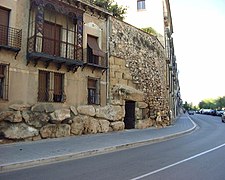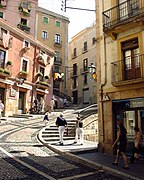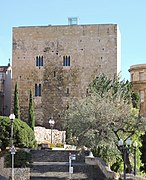Tarragona
| Tarragona municipality | ||
|---|---|---|
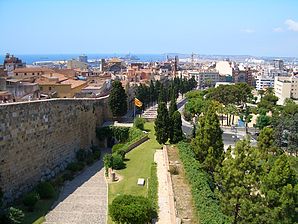
|
||
| coat of arms | Map of Spain | |

|
|
|
| Basic data | ||
| Autonomous Community : | Catalonia | |
| Province : | Tarragona | |
| Comarca : | Tarragonés | |
| Coordinates | 41 ° 7 ′ N , 1 ° 15 ′ E | |
| Height : | 69 msnm | |
| Area : | 55.03 km² | |
| Residents : | 134,515 (Jan 1, 2019) | |
| Population density : | 2,444.39 inhabitants / km² | |
| Postal code : | 43001-43008 | |
| Municipality number ( INE ): | 43148 | |
| administration | ||
| Mayor : | Josep Fèlix Ballesteros Casanova ( PSC ) | |
| Website : | www.tarragona.cat | |
Tarragona is the capital of the province of the same name in the south of the Spanish autonomous region of Catalonia .
history
For the Roman history of Tarragona see main article: Tarraco
218 BC Chr. Conquered Romans , the Iberian town and they made under the name of Tarraco the capital of the province of Hispania Citerior , later Tarraconensis . 27 BC They built a temple in honor of Augustus and Jupiter .
In Tarragona there are many Roman monuments: the Amphitheater , the Circus, the Roman Forum, the grave monument Torre dels Escipions , the Arc de Triomphe Arc de Berà , the Mausoleum of Centcelles and the aqueduct Les Ferreres Aqueduct (also Pont del Diable called). In 2000 the archaeological ensemble of Tarraco was declared a UNESCO World Heritage Site. Remnants of old Roman buildings are discovered again and again during current construction work. At the request of the archaeologists , the construction work is then often interrupted, to the annoyance of the builders.
The Passeig Arqueològic (Archaeological Promenade) stretches along the city wall, which, according to the Roman historians Livius and Pliny, dates back to the Scipions in the 3rd century BC. According to other views , it may be older because of the Cyclopean stone blocks of several tons that were put together without joints. In the Museu Arqueològic , Roman exhibits are exhibited, which also include mosaics , especially a Medusa head . Next to the museum is the Roman Praetorium from the 1st century BC. BC, which here had a square shape and was subject to severe changes in the Middle Ages . The amphitheater lies directly on the coast and was the scene of the martyrdom of Bishop Fructuosus and the deacons Augurius and Eulogius during the Valerian persecution of Christians . In late antiquity , Tarragona was an important bishopric.
In 476, after the fall of Rome and the fall of the Western Roman Empire, Tarragona was occupied rather than conquered by the Visigoths under their king Euric . The Visigoths took over the urban structures and made up a thin upper class. The end of the conditions inherited from antiquity came with the arrival of the Moors; around 716 al-Hurr conquered the city. The city was then in ruins and was largely uninhabited until the Reconquista in the 12th century.
In 1118 Raimund Berengar III conquered . Tarragona, after he had already extended his sphere of influence to the gates of the abandoned city, and rebuilt it as the headquarters of the Church in Catalonia (previously the Catalans were ecclesiastically dependent on the Archdiocese of Narbonne ). The remaining Roman city wall was repaired.
During the Napoleonic Wars on the Iberian Peninsula , Tarragona was besieged from May 3 to June 28, 1811 and finally stormed ( Siege of Tarragona ).
City arms
Tarragona has neither an official coat of arms nor an official flag. However, there are variants that are tolerated by the city council and proposals from the Catalan Society for Genealogy and Heraldry .
Coat of arms of the city of Tarragona (not recognized by the Generalitat de Catalunya )
Flag of the city of Tarragona (not recognized by the Generalitat de Catalunya )
economy
Tarragona has a port that is one of the most important ports in the Mediterranean in terms of handling volume . The operating company of the port therefore has a great political influence in the city parliament.
In the southwest of the city, various industrial plants of the petrochemicals are lined up. BASF , Dow Chemical , Repsol YPF and other corporations have their refineries and other branches there. Covestro operates a factory for the production of diphenylmethane diisocyanates .
Around Tarragona found, inter alia hazelnut orchards and vineyards (see also Spanish wine ). The Priorat, north-west of Tarragona, delivers excellent quality wine .
society
The University of Rovira i Virgili is after their separation from the University of Barcelona in 1991, an independent university with faculties in Tarragona, Reus and Vila-seca .
A certain rivalry exists between the residents of the city of Tarragona and the neighboring city of Reus and El Vendrell .
The main street La Rambla Nova leads directly towards the sea, but ends above a 30 meter high natural steep wall. An artistically designed railing protects the walker from accidentally falling. Laying hands on one of the metal railing posts is said to bring good luck. The Tarragonese say Tocar ferro porta sort in Catalan ! ("Touching iron brings luck").
In the northeast of the city, there is next to the Platja Rabassada , the Platja Savinosa and the large Platja Llarga more beach coves in the conservation area Tamarit-Punta de la Mora , such as Cala Fonda and Platja Roca Plana , only reachable on foot and nude are popular vehicle trailers . The conservation area currently comprises around 100 hectares of land and around 300 hectares of sea. The Platja La Móra on the urbanization of the same name is more frequented because it can be reached by road .
There is a parade at carnival . The dancers on the floats and in the street are dressed up, similar to those in Rio de Janeiro . The spectators are not disguised, but enjoy the display of the mostly lightly clad young dancers.
During Holy Week ( Semana Santa ) there are religious processions that parade through the streets of the city. The city's patron saint is Fructuosus (January 21).
In the first week of July every year, an international fireworks competition takes place in Tarragona , which attracts tens of thousands of spectators every evening from Wednesday to Saturday at 10:30 p.m.
In addition, every year at the end of September in Tarragona the city festival of Saint Tecla ( Festes de Santa Tecla de Tarragona in Catalan) takes place. The focus here is on cultural events, particularly Catalan culture , such as castells , concerts, fireworks or costume parades.
religion
Tarragona is the home of the Catholic Saint Mercedarian Petrus Armengol . King Hermenegild was also martyred here.
Attractions
cathedral
In addition to an old church from 392, the construction of the Cathedral de Santa Maria began in 1171 due to a legacy of Archbishop Hugo von Cervelló. However, the construction activities dragged on until 1331. That is why the cathedral is built in a transitional style from Romanesque to Gothic . The plan is a Greek cross . The church has three naves with a transept and four (of the originally five planned) apses . In the transept, a dome with purely Gothic windows rises above the Romanesque base. The two side doors of the facade are Romanesque, the main portal , completed in 1475, is Gothic with rich sculptural decorations and a mighty rose window above the portal.
In the main apse is the tomb of Don Juan de Aragón, son of Jaime II , who was bishop of Tarragona in the last five years of his life and is decorated with beautiful sculptures . In the main altar, on the Romanesque altar table, there is an important retable from the 15th century. It shows the enthroned God the Father in the middle and scenes from the life of Saint Thekla .
The portal to the cloister made of white marble from the 13th century is particularly worth seeing . In the tympanum of are world leaders and the four Evangelists symbols shown. Biblical scenes can be found on all capitals .
Minor de Costa
Moll de Costa is the name of the northern quay at the old harbor basin and the parallel street. The Moll de Costa, which was laid out at the end of the 19th century and has been open to the public since 1986, is characterized by four historic warehouses (tinglados). The 61 m × 16 m large warehouses, which were built from 1898 and were used to store bulk goods in sacks (corn, cod, almonds, hazelnuts), were initially only 5 m away from the quay and partly consisted of an iron structure with a gable roof. Between 1913 and 1924, they were moved back to a distance of 12 m from the quay to enlarge the loading area and to create tracks for loading cranes. After the commercial use of the Moll de Costa was abandoned, the buildings were restored and are now partially used for changing exhibitions and cultural events. The port museum Museu del Port de Tarragona is located in one of the two younger former storage sheds (refugi 2) on the north side of the Moll de Costa street. Exhibits from Roman times to the present are shown. The facilities of the modern commercial and industrial port are explained in a slide show. The neighboring storage shed (refugi 1) is also used for temporary exhibitions. In the area, some old loading cranes and a shunting steam locomotive remind of the former function of this area.
The port basin of the Moll de Costa is today mostly used as a marina ("Port Tarraco"); there are 64 berths for ocean-going yachts from 30 to 130 m in length and drafts of up to 8 m. Cruise ships up to 140 m in length can also dock here. The western area of the harbor basin is used as a fishing port. Opposite the fishing port is the old fishing district of El Serrallo, which was laid out in the mid-19th century, with the small church of Sant Pere (late 19th century) and the building of the Confraría (brotherhood) de Pescadors de Tarragona with a restaurant on the ground floor.
Moll de Llevant "km 0"
The road on the Moll de Llevant, which borders the Moll de Costa to the east, was developed as a promenade and leisure route for pedestrians, joggers, cyclists and skaters. The 4.75 km long route, which begins between the building of the port authority (Autoritat Portuària) and the marina for sailing and motor boats, also offers an impressive view of the port areas with silos, industrial halls and storage areas for coal. At 3.25 km is the Far de la Banya lighthouse, which was moved here in 1985 from its former location in the Ebro Delta . At the end of the Moll de Llevant is the terminal for cruise ships with a draft of up to 19 m (without restrictions in width and length).
2016: 22 cruise ships (> 13,000 passengers)
2017: 37 cruise ships (> 51,000 passengers)
2018: 57 cruise ships (> 98,000 passengers)
In the master plan (2015–2035) for port development, the following key projects for improving the tourism sector are named:
At Dique dels Prats in the south-west of the industrial port, the construction of a temporary dock for cruise ships (commissioning possible from 2020) is planned. After the consolidation of the cruise sector, a cruise terminal is to be built in the run-up to the sports harbor on the east side of the Moll de Llevant in the medium to long term.
View from Rambla Nova over the train station and port
sons and daughters of the town
- Eduardo Saavedra (1829–1912), civil engineer, architect, historian and archaeologist
- Josep Maria Jujol (1879–1949), architect
- Jaume Vallcorba Plana (1949–2014), philologist, editor and publisher
- Carmen París (* 1966), jazz musician
- Xavier O'Callaghan (* 1972), handball player and handball official
- Ferran Marín i Ramos (* 1974), editor and author
- Natalia Rodríguez (* 1979), middle distance runner
- Joan Olivé (* 1984), motorcycle racer
- Francisco Casilla Cortés (* 1986), football goalkeeper
- Eduard Prades (* 1987), racing cyclist
Town twinning
-
 Avignon ( France ) since 1968
Avignon ( France ) since 1968 -
 Alghero ( Italy ) since 1972
Alghero ( Italy ) since 1972 -
 Orléans ( France ) since 1978
Orléans ( France ) since 1978 -
 Stafford ( UK ) since 1992
Stafford ( UK ) since 1992 -
 Klagenfurt ( Austria ) since 1996
Klagenfurt ( Austria ) since 1996 -
 Pompei ( Italy ) since 2006
Pompei ( Italy ) since 2006
literature
- Franz N. Mehling: Spain. (Knaur's cultural guide). Droemer Knaur, Munich 1981, ISBN 3-426-26037-9 , pp. 651-654.
- Pedro de Palol, Max Hirmer: Spain: Art of the early Middle Ages from the Visigoth Empire to the end of the Romanesque. Hirmer Verlag, Munich 1991, ISBN 3-7774-5730-2 , p. 110.
- Coia Escoda Múrria: El Port de Tarragona . Lunwerg Editores, Barcelona 2002, ISBN 84-7782-843-1 , pp. 211-225.
Web links
- Official website of the Municipality of Tarragona
- University of Rovira i Virgili
- Tarragona 2016
- Museu Nacional Arqueològic de Tarragona (English, Catalan)
- Image portal about Tarragona
- Blog Connexions from Tarragona
Individual evidence
- ↑ Cifras oficiales de población resultantes de la revisión del Padrón municipal a 1 de enero . Population statistics from the Instituto Nacional de Estadística (population update).
- ↑ Port de Tarragona: Estadísticas. Retrieved November 17, 2019 .
- ↑ Port de Tarragona: Infraestructuras en desarrollo. Retrieved November 17, 2019 .








